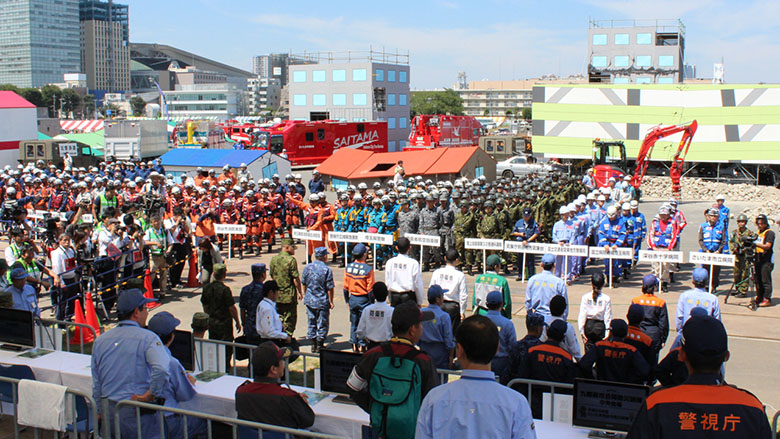Countries of the Europe and Central Asia (ECA) region are regularly affected by adverse natural events. Over the last 30 years, floods and earthquakes alone caused 50,000 fatalities, affected nearly 25 million people, and resulted in US$80 billion in damage. While disaster profiles and vulnerabilities vary across Armenia, the Kyrgyz Republic and Tajikistan; all three countries, however, share in common a predominant seismic risk.
Given the seismic profile of several countries in the ECA region, the World Bank and the Global Facility for Disaster Reduction and Recovery (GFDRR), with support from the Government of Japan and other donors, recently invited government representatives from Armenia, Kyrgyz Republic, and Tajikistan to take part in an Experts Visit to Japan. This visit provided an opportunity for participants to improve their respective crisis management systems by learning first-hand about Japan’s experience in disaster preparedness and response systems at national and local levels. Japan, a country that has accumulated much knowledge and operational experience in disaster risk management (DRM) through its own experience with recurring natural disasters, has actively promoted cooperation at a global level to reduce the number of disaster-related victims. Through "Japan-World Bank Program for Mainstreaming DRM in Developing Countries", the World Bank DRM Hub, Tokyo, GFDRR, and the Government of Japan have been working closely to mainstream DRM in national development planning and investment, including World Bank operations, by capitalizing on Japanese expertise and best practices.
The level of coordination and dedication displayed during public awareness activities in Japan was one of the most impressive features of the visit, according to visiting delegates from the ECA region. In Japan, these can also be included within wider commemorative events such as disaster simulation drills. The Government of Japan held the National Simulation Drills at state level and 36th Comprehensive Disaster Prevention Drill of Nine Prefectural and City Governments, hosted by Saitama City on September 1, 2016, a coordinated effort to simulate a comprehensive emergency response to a major earthquake in the Nankai Trough (off the central and western coast of Japan). This important exercise is normally taken place on "Disaster Prevention Day" in Japan, commemorating the devastated earthquake happened in Kanto region in 1923. On the same day, various disaster simulation drills were taken place in 36 out of 47 prefectures, and mobilized 1 million participants across the country.
Over the course of a week, Armenian, Kyrgyz, and Tajik officials engaged in discussions with a wide range of national agencies and municipal authorities in Japan, which are involved in several DRM activities:
- In Tokyo, delegates also had a Courtesy Call with the State Minister (in charge of disaster management) from the Cabinet Office of Japan – an agency responsible for supervising disaster management efforts at a national level – to discuss challenges and opportunities in implementing DRM measures. Based on observations of the simulation drill in Saitama City, the delegates committed to propose a similar exercise once they return to their respective countries. In terms of follow-up steps, the State Minister offered further collaboration between the DRM Hub, Tokyo and the Cabinet Office in disseminating Japan’s knowledge and expertise in disaster risk management.
- The delegates also met with officials from the Urban Safety Division of Ministry of Land, Infrastructure, Transport and Tourism (MLIT) to discuss lessons learned from the 2011 Great East Japan Earthquake, and learn more about the national system of municipal subsidies, which are used for building more resilient urban fabric.
- In their meeting with the Fire and Disaster Management Agency (FDMA), participants were particularly interested in J-ALERT, which can instantly transmit emergency information, such as earthquake and tsunami early warning, both via satellite and online from the central government to the local governments and designated communication hubs such as major media and mobile operators. The information is then immediately disseminated to local residents through various devices such as outdoor broadcasting systems and cellphones (via emails and text messages).
- The visit also featured concepts of resilient urban planning, and showed how these have evolved in Japan – also known as Bousai Machidukuri. Delegates were also able to meet with the Kobe City Government to study how the City of Kobe was able to learn from the disastrous consequences of the Great Hanshin-Awaji Earthquake in 1995, and re-think their approach to improve municipal preparedness measures and streamline post-earthquake city redevelopment efforts.
- To better understand the function of risk communication measures in Japan, delegates were able to interact with a group of residents in Bunkyo neighborhood in Tokyo, which proactively promote “self-help” approach to improve emergency response capacity at the community level. The delegates also visited the Maiko High School in Kobe City to observe unique initiative to foster young leaders in the community through disaster resilience education is fully integrated into the high school curriculum.
This visit offered valuable insights that will support at-risk countries in the ECA region in mainstreaming disaster preparedness measures and urban resilience considerations into their respective policies and programs. Acknowledging the proactive approaches to DRM, which are undertaken in countries like Japan, the World Bank and GFDRR, are committed to expanding such efforts on seismic risk reduction and management in the ECA region and will continue to support the Governments of Armenia, Kyrgyz Republic, and Tajikistan as they shift away from a reactive disaster response system to a more integrated disaster risk management and resilience-building approach.





